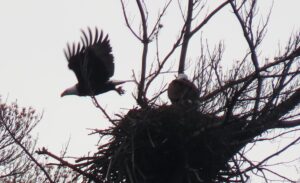By David Fleet
Editor
Brandon Twp.— On a cold, snowy March morning with light fading a pair of bald eagles tended to a nest in northern Oakland County. One of the majestic birds left the nest, secured more than 50 feet above a remote wetland, for perhaps the last fishing trip of the day.
in northern Oakland County. One of the majestic birds left the nest, secured more than 50 feet above a remote wetland, for perhaps the last fishing trip of the day.
The iconic scene is a tribute to conservation and grass-roots awareness, both locally and nationwide.
“Bald eagles are a really great recovery success story, particularly here in Michigan,” said Erin Ford, conservation manager for Audubon Great Lakes.
In the 1960s and 70s the future of bald eagles was bleak.
According to the Michigan Audubon Society there were at one point fewer than 40 pairs of nesting eagles in Michigan and only 38 percent in the 1970s of Michigan’s fledglings.
By 1980 there was complete reproductive failure of fledglings on the Lake Erie shoreline.
“No fledglings were reported in the lakeshore area,” she said. “Zero.”
Back then, lack of young was due to the use of DDT pesticides and PCBs those contaminates built up in the tissues of these predator birds, causing reproductive failure by thinning of the egg shells, she said.
“The eggs would break when they were trying to hatch them,” she said.
Banning of DDT in Michigan was 1969 and then nationally in 1972. Equally significant was the protection under the endangered species act, as well as the migratory bird treaty act and the golden eagle protection act.
Fifty years later the conservation efforts are paying off.
In a 2019 statewide survey, over 1,600 nests and 900 breeding pairs were reported. In comparison in the 1980s there were only 83 breeding pairs and in 2000 that number had already risen to 359.
“All of the protection really helped bring the birds back from the brink of extinction,” Ford said. “It’s pretty magical.”
Nationwide, there are now more than 300,000 bald eagles in the wild, the all time low was in the 417 known nesting pairs in the early 1960s.
With the growth of the eagle population birds in Michigan are now expanding south in the lower peninsula where the high population are residing, she said.
“We see them more often and they are adapting to more urban landscapes,” she said. “Keeping in mind, with protection, their nests are also protected and we encourage watch from a distance. If they flush off the nests, you’re too close.”
The adaptation has additional challenges to the bald eagle population.
“Bald eagles are very good scavengers,” she said. “It’s not uncommon to see eagles eating roadkill or carcasses such as fish in an effort to stay well fed. However, now bald eagles are dealing with lead poisoning on a large scale.”
New studies across 38 states have been released that report 46 percent of the 1,210 bald and golden eagles collected had died due to lead poisoning. The lead could stunt the growth of bald and golden eagles by just under 4 percent each year.
In 1991 lead shot was banned for waterfowl hunting due to the contamination.
“While lead shot can’t be used in the wetland areas, lead can be found by angler fishing gear,” she said. “Lead weights and lures are left behind. The eagles who are also scavengers are also impacted by lead shot consumed and used to hunt deer along with other animals rather than waterfowl.”
In 2020, the Michigan United Conservation Clubs, or MUCC, passed a resolution to seek alternatives to lead in hunting ammunition, and fishing sinkers or jig heads. In some cases, the alternatives perform better than lead products, the MUCC stated.
“Be responsible about leaving lead weights behind,” she said. “There are alternatives to the lead weights. The recovery of this majestic bird reminds us of the responsibility we have of being good stewards.”
